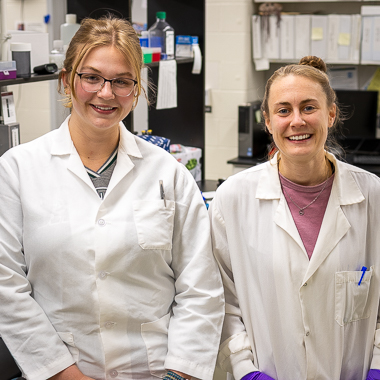Researchers determine that faulty immune cells make WHIM mice more prone to HPV infections
Article Highlights
-
Researchers confirmed that mice with the WHIM-causing CXCR4 mutation accurately mimic the human disease. These WHIM mice showed higher susceptibility to HPV-like infections (MmuPV1) at low virus doses, developed more and larger warts, and had impaired immune cell responses.
-
Through bone marrow transplants, the researchers demonstrated that the mutation in immune cells directly causes the increased risk of viral infection in WHIM mice. Transplanting healthy bone marrow into WHIM mice prevented new infections and restored immune responses.
-
The study paves the way for innovative treatments like bone marrow editing to restore immune function in WHIM patients without requiring harmful chemotherapy or radiation. This preclinical model offers insights into both WHIM disease and HPV infection mechanisms in general.
Researchers at MSU and the Univ. of Wisconsin have uncovered a new and important insight about a rare immune disorder. WHIM syndrome – Warts, Hypogammaglobulinemia, Infections, and Myelokathexis – can lead to conditions such as persistent skin and genital warts and increased risk of HPV-related cancer. Researchers have previously determined that WHIM is caused by a mutation in a gene known as CXCR4.

In new research, published in the journal PLOS Pathogens, Wei Wang, an assistant professor in MSU’s department of Microbiology, Genetics, & Immunology, explained that the research team performed studies on a mouse model with the same mutation to better understand the disease and find ways to treat it.
“Our collaborator in France generated a CRISPR Cas9 knock-in mouse model using the same CXCR4 mutation found in WHIM patients,” Wang said. “They characterized the mouse model with low circulating immune cells and dysregulated localization of T cells in spleen and lymph nodes (as in humans). But nobody knows whether this mouse model is good for studying pathogenesis in the WHIM patient.”
In order to confirm that the mouse model accurately represented human WHIM infections, the researchers infected the mice with a version of HPV known as MmuPV1. Wang explained that this virus was discovered in 2011 and is the only papillomavirus known to infect laboratory mice. They found that, just like human WHIM patients, WHIM mice developed warts, or papillomas, more easily than healthy mice, especially when exposed to low doses of the virus.
“At high dose, either wild-type mice without the mutation or mice with the mutation
have similar high susceptibility to the high-dose infection,” Wang said. “But as I
titrated down the dose of the virus, normally immunocompetent mice who are healthy
and don’t have the mutation can clear the virus spontaneously. That’s what we’ve discovered
in the past. But these mice, bearing the same mutation as the WHIM patients, could
not even clear a low-dose infection of mouse papillomavirus, and they got a higher
frequency of high-grade dysplasia (abnormal cells) and cancer in the infected sites.”
The immune response in WHIM mice was impacted, too — while normal mice showed immune
cell movement in response to the virus, this didn’t happen in WHIM mice. And WHIM
mice had more and larger warts, with fewer immune cells in the wart tissue.
Once the mouse model was validated, the researchers used it to investigate another outstanding question about WHIM infections: whether the immune cell mutation causes the higher risk of infection or if the mutation was on a different type of cell.
To test this, the researchers transplanted bone marrow cells from mice with the WHIM mutation into healthy mice. This replaced the healthy mice's immune cells and all their blood-forming cells with cells that had the CXCR4 mutation. They found that the mutant mice were more prone to viral infections.
Next, they tested if it would be possible to cure the mice with the WHIM mutation
by giving them a bone marrow transplant from the healthy mice, and it worked. Transplanting
healthy bone marrow into the diseased mice prevented them from getting new mouse papillomavirus
infections, and it restored the immune cell movement into the warts.
Wang explained that they are now exploring whether a better treatment option could
be developed by restoring immune cells in WHIM recipients using advanced bone marrow
editing technology. WHIM patients are already immunosuppressed, so to perform a bone
marrow transplant, they currently need chemotherapy or radiation therapy to further
suppress their immune systems. This helps them accept the donor’s immune cells. Without
this step, the patient’s body might not accept the donor cells and could reject the
transplant.
“That’s why we think this is an exciting preclinical model that we can use to test new strategies to rescue their immune function without giving them radiation,” Wang said. “We’re hoping to discover new mechanisms that support the viral infection in WHIM disease which may provide some clues for HPV infection in healthy individuals, too.”



